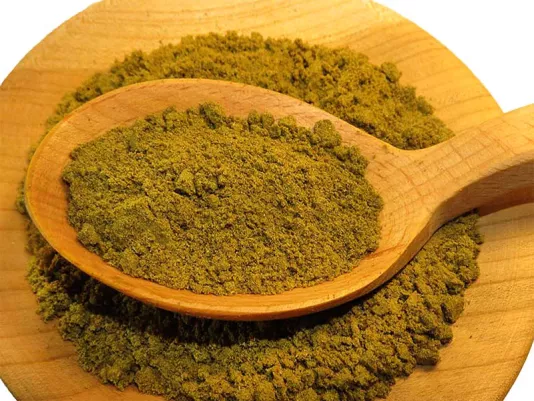Delicious Vegetable Shish Kebab
Delicious vegetable shish kebab is a recipe for Georgian cuisine, barbecue is not only meat, poultry or fish, but also vegetables.

Khmeli-suneli is an aromatic mix of dried herbs and seeds that I value for its balanced character and natural expressiveness. Over years of cooking, I’ve noticed that khmeli-suneli helps reveal the true flavor of ingredients without masking them. It lacks the harsh notes of some spicy blends but has a softness that unfolds gradually, especially with heat. I always buy it in small portions because the aroma fades quickly during storage. The best way to store it is in a tightly sealed jar, away from moisture and light. It adds a feeling of homey warmth even to the simplest everyday meals – and that’s why I can’t imagine my kitchen without it.
When choosing khmeli-suneli, I first look at the color and aroma. A good blend has a light green or slightly olive shade and an even texture without clumps. A sharp smell or very dark color indicates old or poorly dried ingredients. Over the years, I’ve learned to trust my nose: real khmeli-suneli smells herbal, with a slightly sweet trace of fenugreek. I always check the composition – the classic version has no salt or coloring, only natural components. I usually buy it from spice shops where it’s stored in airtight containers rather than exposed to air. If possible, I prefer finely ground blends – they release aroma better when heated. I once tried making my own version but quickly realized that without the right proportions, the aroma becomes too strong. So now I choose a ready-made but high-quality seasoning and carefully watch the expiration date, since even the best khmeli-suneli loses its character after a year of storage.
Khmeli-suneli doesn’t require complex preparation but has its subtleties. I always add it at the end of cooking or right after removing the dish from heat – that way, the aroma doesn’t burn off. If the dish is liquid, like a sauce or soup, the spice can be mixed with a spoonful of hot liquid before adding – this helps it distribute evenly. In dry mixes, such as marinades, I combine khmeli-suneli with a bit of oil to activate the herbs’ essential oils. In my experience, this makes the flavor deeper and rounder. I don’t recommend frying the blend with onions or garlic – high heat destroys its aroma. If the spice has been stored for several months, I lightly warm it in a dry pan over low heat for just 10-15 seconds before use: that’s enough to revive the aroma without burning it. It’s also important not to combine khmeli-suneli with too many other seasonings – an excess of herbs can create bitterness. Proper preparation ensures a natural harmony of taste and aroma in the finished dish.
When cooking with spices, I always remember that aromatic herbs dislike high temperatures. Khmeli-suneli is especially delicate – prolonged heating dulls its flavor and can even cause mild bitterness. If I add it to stewed or baked dishes, I do so 5-10 minutes before cooking ends. For dishes cooked over open flame or grill, it’s best to mix the spice with oil and apply it right before grilling – this protects the herbs from overheating. Through practice, I’ve found that a temperature around 160-170°C (320-340°F) is safe for most sauces and stewed vegetables with khmeli-suneli: the aroma develops but doesn’t burn. When adding it to baked goods, I always pair it with neutral ingredients – flour, eggs, or butter – that soften its impact. During heat treatment, patience is key: excessive heat destroys the essential oils that form the true fragrance of the seasoning. What’s needed is attentiveness to the moment when the dish still “breathes” aroma but isn’t overheated.
I always consider khmeli-suneli a universal ingredient that works equally well with meat and vegetables. It particularly enhances the flavor of chicken, eggplant, beans, tomatoes, and fish. To create a warm, rich profile, I pair it with garlic or ground pepper. For delicate dishes, I combine it with fresh herbs – parsley, dill, or mint. In cream- or sour cream–based sauces, khmeli-suneli adds pleasant herbal depth without bitterness. Over the years, I’ve noticed that too much of it in dishes with eggs or cheese flattens the flavor, so I use it sparingly. Interestingly, even in cold dishes like vegetable pâtés or spreads, it holds its own – you just need to let it sit in oil for a few minutes to release its aroma. I don’t like pairing khmeli-suneli with smoky or curry flavors – they clash. The key to success is balance and a sense of proportion.
The most common mistake is using too much of the spice. Even a teaspoon in a small dish can make the aroma overly strong. I always start with half a portion and add more if needed. Another problem is improper storage: moisture and sunlight quickly strip khmeli-suneli of its fragrance and can alter its taste. That’s why I store it in a glass jar with a lid, in a dark place. Another risk is low-quality blends containing salt, starch, or coloring – they distort the natural aroma. I always recommend buying spices by weight so you can smell them before purchasing. During cooking, remember that khmeli-suneli doesn’t replace salt or pepper – it only enhances flavor. If a dish tastes “empty”, it doesn’t mean you need more spice – it might need acidity or fat instead. Over years of experience, I’ve realized that the secret to great results isn’t in the amount of seasoning but in the attention you give to every detail.